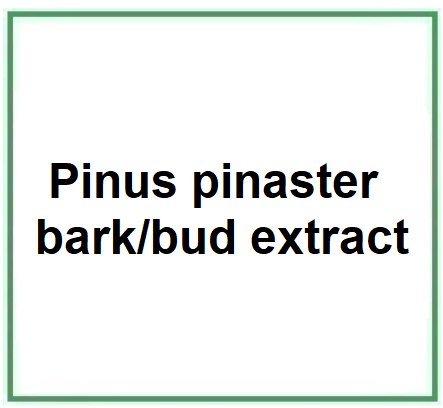Pinus pinaster bark/bud extract is obtained from Pinus pinaster commonly known as the maritime pine or French maritime pine (a plant belonging to the botanical family Pinaceae), is a pine tree native to the western Mediterranean region.
Name breakdown and function of the components
- Pinus pinaster - This is the scientific name for the Maritime Pine, a pine species native to the Mediterranean region.
- Bark - Refers to the tree's bark. The bark of the Maritime Pine is rich in proanthocyanidins, substances with powerful antioxidant properties.
- Bud - Refers to the young shoots of the tree. The buds are rich in essential oils and other compounds.
- Extract - Indicates that the product is a concentration of some components of the bark or buds.
Description and function of the raw materials used in production
- Pinus pinaster bark and buds - The primary sources of proanthocyanidins, essential oils, and other beneficial compounds.
- Solvent (like water or ethyl alcohol) - Used to extract the beneficial compounds from the bark and buds.
Summary of the extraction process step by step
- Collection and preparation of the bark and buds - Bark and buds are harvested from trees and cleaned from impurities.
- Shredding - The bark and buds are shredded into smaller pieces to increase the surface area in contact with the solvent.
- Extraction - The shredded material is soaked in the solvent for a specified period, allowing the compounds to diffuse into the solvent.
- Filtration - Once extraction is complete, the solution is filtered to remove any residual solid particles.
- Evaporation - The solvent is then evaporated, leaving behind the concentrated Pinus pinaster extract.
- Stabilization and preservation - The extract may be further treated or stabilized for long-term storage.

What it is for and where
Cosmetics
Anti-sebum. Controls and reduces emissions from the sebaceous glands, which are responsible for greasy, enlarged pores in the skin, where it occurs, particularly on the forehead, cheeks, nose and hair. Adjuvant in the treatment of acne.
Antimicrobial agent. This ingredient is able to suppress or inhibit the growth and replication of a broad spectrum of microorganisms such as bacteria, fungi and viruses by making the stratum corneum temporarily bactericidal and fungicidal.
Antioxidant agent. Ingredient that counteracts oxidative stress and prevents cell damage. Free radicals, pathological inflammatory processes, reactive nitrogen species and reactive oxygen species are responsible for the ageing process and many diseases caused by oxidation.
Oral care agent. This ingredient can be placed in the oral cavity to improve and/or maintain oral hygiene and health, to prevent or improve a disorder of the teeth, gums, mucous membrane. It provides cosmetic effects to the oral cavity as a protector, cleanser, deodorant.
Skin conditioning agent. It is the mainstay of topical skin treatment as it has the function of restoring, increasing or improving skin tolerance to external factors, including melanocyte tolerance. The most important function of the conditioning agent is to prevent skin dehydration, but the subject is rather complex and involves emollients and humectants that can be added in the formulation.
UV absorber. It acts by intercepting ultraviolet light before it can cause damage by reducing its energy through dissipation and returning it to a lower energy state.
Commercial applications
Cosmetic and Skincare Products: Due to its potent antioxidant properties, it's utilized in creams, serums, and lotions to combat free radical damage and promote skin elasticity.
Dietary Supplements: Pycnogenol, a compound derived from this tree, is often used as a dietary supplement for a range of health benefits.
Circulation Products: Due to its properties, it can be used in products aimed at enhancing circulation.
Properties
Antioxidant: Protects the skin from free radical damage.
Anti-inflammatory: Assists in reducing skin inflammation and irritation.
Enhances Circulation: Can promote better blood circulation.
Studies
The essential oil of Pinus pinaster has demonstrated significant anti-inflammatory activities, has proven useful in wound healing (1), is a source of procyanidin oligomers that play a protective role in the skin (2) and an extract of the bark, Pycnogenol®, has been shown to improve skin barrier function and extracellular matrix homeostasis (3).
References_____________________________________________________________________
(1) Tümen İ, Akkol EK, Taştan H, Süntar I, Kurtca M. Research on the antioxidant, wound healing, and anti-inflammatory activities and the phytochemical composition of maritime pine (Pinus pinaster Ait). J Ethnopharmacol. 2018 Jan 30;211:235-246. doi: 10.1016/j.jep.2017.09.009.
(2) Touriño S, Selga A, Jiménez A, Juliá L, Lozano C, Lizárraga D, Cascante M, Torres JL. Procyanidin fractions from pine (Pinus pinaster) bark: radical scavenging power in solution, antioxidant activity in emulsion, and antiproliferative effect in melanoma cells. J Agric Food Chem. 2005 Jun 15;53(12):4728-35. doi: 10.1021/jf050262q.
(3) Grether-Beck S, Marini A, Jaenicke T, Krutmann J. French Maritime Pine Bark Extract (Pycnogenol®) Effects on Human Skin: Clinical and Molecular Evidence. Skin Pharmacol Physiol. 2016;29(1):13-7. doi: 10.1159/000441039.
![]() Pinus pinaster bark/bud extract
Pinus pinaster bark/bud extract 


